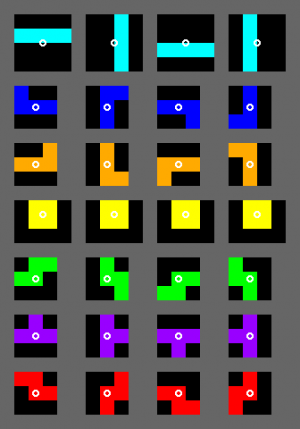From Hard Drop Tetris Wiki
m (Reverted edit of 24.239.244.177, changed back to last version by Jujubo) |
(begin to describe rotation system) |
||
| Line 15: | Line 15: | ||
'''Tetris DX''' was a Game Boy Color game as an enhancement of Nintendo's original [[Tetris (Game Boy)|Game Boy Tetris]], with two added gameplay modes (Ultra, lasting 3 minutes; and Vs. CPU, a match against the computer), a profile/save feature, and color graphics on [[Game Boy Color]] and above. In addition, the game's [[rotation system]] had a glitch which lets a player move any [[tetromino]] except ''O'' upward by holding the direction against a wall while rotating in the opposite direction. | '''Tetris DX''' was a Game Boy Color game as an enhancement of Nintendo's original [[Tetris (Game Boy)|Game Boy Tetris]], with two added gameplay modes (Ultra, lasting 3 minutes; and Vs. CPU, a match against the computer), a profile/save feature, and color graphics on [[Game Boy Color]] and above. In addition, the game's [[rotation system]] had a glitch which lets a player move any [[tetromino]] except ''O'' upward by holding the direction against a wall while rotating in the opposite direction. | ||
== Rotation system == | |||
[[Image:SRS-pieces.png|thumb|All rotation states of all seven tetrominoes in SRS. From top to bottom: I, J, L, O, S, T, Z. The circle doesn't appear in the game; it helps to illustrate the axis on which each tetromino rotates. Colors differ between SRS and TDX. Notice that at least J, L, and T tetrominoes start oriented like the third column.]] | |||
The rotation system is an early version of what would become [[SRS]]. | |||
Tetrominoes of width 3 rotate as if in a bounding box, though L, J, and T start flat side up. | |||
first tries rotation about the center of the bounding box (the white circle in the SRS diagram), then rotation about the bottom of the bounding box (the space above the white circle in the third column) | |||
<br clear="all"> | <br clear="all"> | ||
== See also == | == See also == | ||
{{Nintendo games}} | {{Nintendo games}} | ||
== External links == | |||
*[http://www.din.or.jp/~koryan/tetris/roll-o2.htm#03 Koryan's description of Sega Tetris, TGM, and Tetris DX rotation systems (Japanese language)] | |||
**[http://translate.google.com/translate?u=http%3A%2F%2Fwww.din.or.jp%2F%7Ekoryan%2Ftetris%2Froll-o2.htm&langpair=ja%7Cen&hl=en&ie=UTF-8&oe=UTF-8&prev=%2Flanguage_tools English translation using Google Language Tools] | |||
[[Category:Games List]] | [[Category:Games List]] | ||
Revision as of 19:36, 18 August 2007
|
Tetris DX | |
|---|---|
| [[File:{{{boxart}}}|175px]] | |
| Developer(s) | Nintendo |
| Publisher(s) | Nintendo |
| Release Date(s) | 21, Oct 1998 (Japan) 31, Oct 1998 (USA) 1, Jul 1999 (Europe) |
| Platform(s) | Game Boy Color |
|
Gameplay Info | |
| Next pieces | 1 |
| Playfield dimensions | 10x18 |
| Hold piece | No |
| Hard drop | No |
| Rotation system | {{{system}}} |
| Has 180 rotation | {{{180}}} |
| Adjustable tuning | {{{tuning}}} |
| Garbage attack type | {{{garbage}}} |
| Garbage blocking type | {{{blocking}}} |
| Website | {{{website}}} |
 |

|
Not to be confused with Tetris Deluxe, a game released for western mobile phones.
Tetris DX was a Game Boy Color game as an enhancement of Nintendo's original Game Boy Tetris, with two added gameplay modes (Ultra, lasting 3 minutes; and Vs. CPU, a match against the computer), a profile/save feature, and color graphics on Game Boy Color and above. In addition, the game's rotation system had a glitch which lets a player move any tetromino except O upward by holding the direction against a wall while rotating in the opposite direction.
Rotation system

The rotation system is an early version of what would become SRS. Tetrominoes of width 3 rotate as if in a bounding box, though L, J, and T start flat side up. first tries rotation about the center of the bounding box (the white circle in the SRS diagram), then rotation about the bottom of the bounding box (the space above the white circle in the third column)
See also
Tetris and other puzzle games published by Nintendo {{}}
Console: Tetris (NES, Nintendo) | Tetris 2 | Tetris & Dr. Mario | 3D Tetris | The New Tetris | Tetris 99
Handheld: Tetris (Game Boy) | Tetris Blast | Tetris DX | Pokémon Tetris | Tetris DS | Tetris Axis
Topics: Nintendo Rotation System | Nintendo Wi-Fi Connection